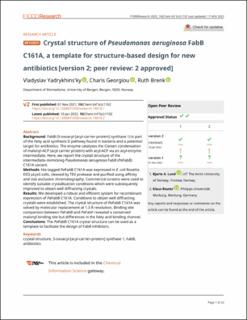| dc.contributor.author | Yadrykhinsky, Vladyslav | |
| dc.contributor.author | Georgiou, Charis | |
| dc.contributor.author | Brenk, Ruth | |
| dc.date.accessioned | 2023-03-13T09:34:27Z | |
| dc.date.available | 2023-03-13T09:34:27Z | |
| dc.date.created | 2022-02-17T14:38:08Z | |
| dc.date.issued | 2022 | |
| dc.identifier.issn | 2046-1402 | |
| dc.identifier.uri | https://hdl.handle.net/11250/3057878 | |
| dc.description.abstract | Background: FabB (3-oxoacyl-[acyl-carrier-protein] synthase 1) is part of the fatty acid synthesis II pathway found in bacteria and a potential target for antibiotics. The enzyme catalyses the Claisen condensation of malonyl-ACP (acyl carrier protein) with acyl-ACP via an acyl-enzyme intermediate. Here, we report the crystal structure of the intermediate-mimicking Pseudomonas aeruginosa FabB (PaFabB) C161A variant.
Methods: His-tagged PaFabB C161A was expressed in E. coli Rosetta DE3 pLysS cells, cleaved by TEV protease and purified using affinity and size exclusion chromatography. Commercial screens were used to identify suitable crystallization conditions which were subsequently improved to obtain well diffracting crystals.
Results: We developed a robust and efficient system for recombinant expression of PaFabB C161A. Conditions to obtain well diffracting crystals were established. The crystal structure of PaFabB C161A was solved by molecular replacement at 1.3 Å resolution. Binding site comparison between PaFabB and PaFabF revealed a conserved malonyl binding site but differences in the fatty acid binding channel.
Conclusions: The PaFabB C161A crystal structure can be used as a template to facilitate the design of FabB inhibitors. | en_US |
| dc.language.iso | eng | en_US |
| dc.publisher | F1000 | en_US |
| dc.rights | Navngivelse 4.0 Internasjonal | * |
| dc.rights.uri | http://creativecommons.org/licenses/by/4.0/deed.no | * |
| dc.title | Crystal structure of Pseudomonas aeruginosa FabB C161A, a template for structure-based design for new antibiotics | en_US |
| dc.type | Journal article | en_US |
| dc.type | Peer reviewed | en_US |
| dc.description.version | publishedVersion | en_US |
| dc.rights.holder | Copyright 2022 The Author(s) | en_US |
| dc.source.articlenumber | F1000 Research | en_US |
| cristin.ispublished | true | |
| cristin.fulltext | original | |
| cristin.qualitycode | 1 | |
| dc.identifier.doi | 10.12688/f1000research.74018.2 | |
| dc.identifier.cristin | 2002943 | |
| dc.source.journal | F1000 Research | en_US |
| dc.relation.project | Norges forskningsråd: 273588 | en_US |
| dc.relation.project | Norges forskningsråd: 245828 | en_US |
| dc.relation.project | Norges forskningsråd: 245922 | en_US |
| dc.identifier.citation | F1000 Research. 2022, 10, 1102. | en_US |
| dc.source.volume | 10 | en_US |

